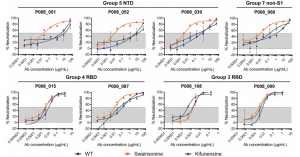A group from King’s College London, etc. has reported on characteristics of neutralizing antibodies obtained from SARS-CoV-2-infected three donors.
https://www.ncbi.nlm.nih.gov/pmc/articles/PMC8015430/pdf/main.pdf
Authors have isolated total 107 SARS-CoV-2 Spike-specific mAbs from three SARS-CoV-2-infected donors, P003 (hospitalized and spent time in ICU), P054 (symptomatic but no hospitalization), and P008 (SARS-CoV-2 infected, but asymptomatic). In total 107 mAbs, 35.5% of the Spike reactive mAbs were RBD-specific, 32.7% were NTD specific, 0.9% bound S1 only, and 30.8% mAbs only bound Spike. 43.9% of total 107 mAbs showed neutralizing activity, and the majority about 70% of the neutralizing Abs (nAbs) targeted RBD and about 20% of nAbs targeted NTD.
Overall, highly potent nAbs targeting RBD and NTD had similar titers, IC50 ranged from 2.3 to 488ng/mL.
RBD-specific mAb P008_108 showed the most potent anti-SARS-CoV-2 neutralizing activity, IC50 of 2.3 ng/mL, and P008_056 neutralized SARS-CoV-2 with an IC50 of 14 ng/mL making this one of the most potent NTD nAbs reported thus far.
It is very curious to know that the nAbs with higher neutralizing activity were obtained from asymptomatic donor.
Since NTD is heavily glycosylated than RBD, the effect of glycosylation onto nAbs were studied by using glycosidase inhibitors such as kifunensine and swainsonine (see figure below). These results suggest that glycan structures can affect nAb epitope recognition either through modulating the conformation of Spike or altering the accessibility of nAb epitopes.

